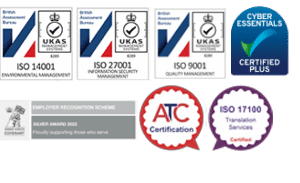When writing text you wish to be changed into another language, it can be helpful to know how best to optimise your content for translation.
Not every word or phrase has a direct translation from one language to another, especially when it comes to highly technical and specialist content. If you are looking to create content with the purpose of having it translated, take in these top tips for writing translation-friendly content below.
Keeping sentences short
Languages can expand significantly in translation. If your original sentences are on the long side, they could end up taking a lot more space in translation! Besides this, long-running sentences can sometimes be unclear. To avoid issues with your content or layout in translation, opt for writing short sentences.
Using standard wording
As a general rule, technical words will require more research time for a translator. For example, the term “fast heart rate” instead of “tachycardia”.
Writing for your audience
If your content is aimed at a general audience, avoid using professional jargon. It is always a good idea to provide the translators with the context of audience, purpose and style.
Maintaining standard English word order
A standard sentence will follow the structure: Subject – verb – object. He (subject) – received (verb) – a letter (object). Switching words around, for example by saying “A letter, he did receive.”, will create confusion.
Avoiding humour, sayings and idioms
Humour can be a good way to keep your content relevant and interesting. However, it’s difficult to translate humour into other languages as it often relies on a cultural or linguistic foundation that may not be shared.
Practising writing in the active voice
The passive voice can often sound heavy and introduce ambiguity. To keep your content sounding clear and fluent, opt for the more natural-sounding active voice. Use “He had received a letter” rather than “A letter had been received by him”.
Using ‘this’ and ‘that’
It is common usage to skip these pronouns: “The letter he received…”. But when we omit connecting elements, we rely on the reader to infer what is meant instead of making it clear. So to avoid ambiguity, ensure that you do not omit these pronouns: “The letter that he received…”
Proofreading your writing
If auto-correct taught us one thing, it is that changing a single letter can alter the meaning of the whole sentence. Often, translators can spot errors in the original text and must seek clarification, which can cause delays. If not picked up on, an error, such as a wrong date, could appear in the translation. To avoid this, it is best to proofread yourself or even get someone else to check your work.
Thinking about clarity
Write content with clarity in mind. Keep in mind, would someone who is not in your field of work be able to understand everything? Abbreviations and acronyms are good examples – they might be clear to you but not to everyone else. If you have to use them, introduce them in their full form in the first instance.
Ensuring your terminology is consistent
When you introduce a core concept in your work, use the same term for it throughout. Consistency is key. It will improve clarity for your readers and minimise research time for your translators. It is a great practice to create a term glossary and share it with your translation team to make the process run even smoother.
Why use DA Languages to translate your writing?
DA Languages have over 25 years of experience providing expert translation and interpreting services. We cover over 450 languages and dialects so we can support projects of any size and even in the rarest of languages.
We have a proven record of return on investment and can integrate our solutions to your business in order to best support your local and global development goals.
If you would like to find out more about our services please don’t hesitate to get in touch and a member of our dedicated team will be happy to help!



